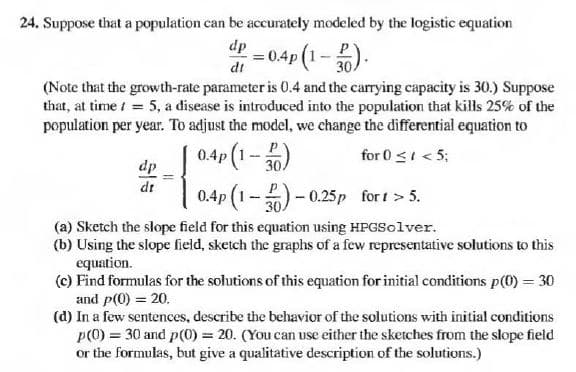24. Suppose that a population can be accurately modeled by the logistic equation dp di =0.4p (1-). (Note that the growth-rate parameter is 0.4 and the carrying capacity is 30.) Suppose that, at time / 5, a disease is introduced into the population that kills 25% of the population per year. To adjust the model, we change the differential equation to 0.4p (1-30 for 0 <1 < 5; dp dr 0.4p (1-) - 0.25p for t > 5. (a) Sketch the slope field for this equation using HPGSolver. (b) Using the slope field, sketch the graphs of a few representative solutions to this equation. (c) Find formulas for the solutions of this equation for initial conditions p(0) = 30 and p(0) = 20. (d) In a few sentences, describe the behavior of the solutions with initial conditions p(0) = 30 and p(0) = 20. (You can use either the sketches from the slope field or the formulas, but give a qualitative description of the solutions.)
24. Suppose that a population can be accurately modeled by the logistic equation dp di =0.4p (1-). (Note that the growth-rate parameter is 0.4 and the carrying capacity is 30.) Suppose that, at time / 5, a disease is introduced into the population that kills 25% of the population per year. To adjust the model, we change the differential equation to 0.4p (1-30 for 0 <1 < 5; dp dr 0.4p (1-) - 0.25p for t > 5. (a) Sketch the slope field for this equation using HPGSolver. (b) Using the slope field, sketch the graphs of a few representative solutions to this equation. (c) Find formulas for the solutions of this equation for initial conditions p(0) = 30 and p(0) = 20. (d) In a few sentences, describe the behavior of the solutions with initial conditions p(0) = 30 and p(0) = 20. (You can use either the sketches from the slope field or the formulas, but give a qualitative description of the solutions.)
Calculus: Early Transcendentals
8th Edition
ISBN:9781285741550
Author:James Stewart
Publisher:James Stewart
Chapter1: Functions And Models
Section: Chapter Questions
Problem 1RCC: (a) What is a function? What are its domain and range? (b) What is the graph of a function? (c) How...
Related questions
Concept explainers
Contingency Table
A contingency table can be defined as the visual representation of the relationship between two or more categorical variables that can be evaluated and registered. It is a categorical version of the scatterplot, which is used to investigate the linear relationship between two variables. A contingency table is indeed a type of frequency distribution table that displays two variables at the same time.
Binomial Distribution
Binomial is an algebraic expression of the sum or the difference of two terms. Before knowing about binomial distribution, we must know about the binomial theorem.
Topic Video
Question
Please solve "c" and "d" part, not "a" and "b" part.

Transcribed Image Text:24. Suppose that a population can be accurately modeled by the logistic equation
dp =04p (1- 30)
dt
(Note that the growth-rate parameter is 0.4 and the carrying capacity is 30.) Suppose
that, at time i = 5, a disease is introduced into the population that kills 25% of the
population per year. To adjust the model, we change the differential equation to
0.4p (1-P
for 0<1 < 5;
dp
30.
dr
0.4p (1 -)- 0.25p fort > 5.
(a) Sketch the slope field for this equation using HPGSolver.
(b) Using the slope field, sketch the graphs of a few representative solutions to this
equation.
(c) Find formulas for the solutions of this equation for initial conditions p(0) = 30
and p(0) = 20.
(d) In a few sentences, describe the behavior of the solutions with initial conditions
p(0) = 30 and p(0) = 20. (You can use either the sketches from the slope field
or the formulas, but give a qualitative description of the solutions.)
Expert Solution
This question has been solved!
Explore an expertly crafted, step-by-step solution for a thorough understanding of key concepts.
This is a popular solution!
Step 1: Given
VIEWStep 2: P(t) when t = [0,5)
VIEWStep 3: p(t), When t= 0, p(0) =20
VIEWStep 4: p(t), When t= 0, p(0) =30
VIEWStep 5: P(t) when t > 5.
VIEWStep 6: P(t) for t> 5 For case a) when t = 0 , p(0) = 20.
VIEWStep 7: P(t) for t> 5 For case b) when t = 0 , p(0) = 30.
VIEWStep 8: P(t) for case (a)
VIEWStep 9: For case b)
VIEWTrending now
This is a popular solution!
Step by step
Solved in 9 steps with 2 images

Knowledge Booster
Learn more about
Need a deep-dive on the concept behind this application? Look no further. Learn more about this topic, calculus and related others by exploring similar questions and additional content below.Recommended textbooks for you

Calculus: Early Transcendentals
Calculus
ISBN:
9781285741550
Author:
James Stewart
Publisher:
Cengage Learning

Thomas' Calculus (14th Edition)
Calculus
ISBN:
9780134438986
Author:
Joel R. Hass, Christopher E. Heil, Maurice D. Weir
Publisher:
PEARSON

Calculus: Early Transcendentals (3rd Edition)
Calculus
ISBN:
9780134763644
Author:
William L. Briggs, Lyle Cochran, Bernard Gillett, Eric Schulz
Publisher:
PEARSON

Calculus: Early Transcendentals
Calculus
ISBN:
9781285741550
Author:
James Stewart
Publisher:
Cengage Learning

Thomas' Calculus (14th Edition)
Calculus
ISBN:
9780134438986
Author:
Joel R. Hass, Christopher E. Heil, Maurice D. Weir
Publisher:
PEARSON

Calculus: Early Transcendentals (3rd Edition)
Calculus
ISBN:
9780134763644
Author:
William L. Briggs, Lyle Cochran, Bernard Gillett, Eric Schulz
Publisher:
PEARSON

Calculus: Early Transcendentals
Calculus
ISBN:
9781319050740
Author:
Jon Rogawski, Colin Adams, Robert Franzosa
Publisher:
W. H. Freeman


Calculus: Early Transcendental Functions
Calculus
ISBN:
9781337552516
Author:
Ron Larson, Bruce H. Edwards
Publisher:
Cengage Learning